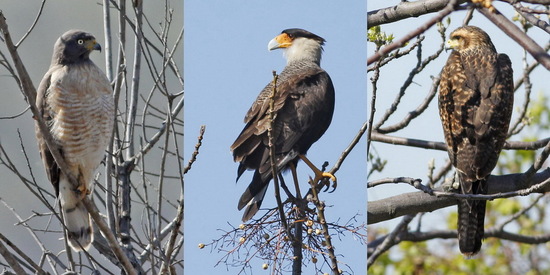Three raptors
These three raptors along with the Chimango Caracara are ever present at the reserve. They belong to two different families. In Accipitridae, we find Roadside Hawk
Rupornis magnirostris (left) and Harris's Hawk Parabuteo unicinctus (right), and in Falconidae, Southern Caracara Caracara plancus (center) and Chimango Caracara
Milvago chimango absent in the photo. The Harris's Hawk and the Southern Caracara are practically the same size (approx 50 in average) and bigger than the Roadside Hawk and the Chimango Caracara (approx 40)
The Family Accipitridae includes hawks and eagles. The family Falconidae, caracaras, falcons, forest-falcons and kestrels. They share characteristics like the fleshy cere which covers the base of the bill, the hallux (hindtoe) which opposes the three forward toes, the habit to capture prey with feet, reversed sexual size dimorphism (female is bigger than male), binocular vision. Among the differences, the colour of the eyes. Falconids mostly have brown eyes and accipitrids, hazel, red, yellow or white (like the Roadside Hawk).
All accipitrids build nests out of sticks. Falconids instead nest in tree cavities or reuse abandoned nests adding sticks. There are some exceptions like the Southern and the Chimango Caracaras.
Most accipitrids have a well marked supraorbital ridge which makes them look fierce. Falconids have 15 ossified toracic vertebrae.
Molt of flight-feathers in accipitrids is from primary P1, the innermost to P10, the outermost. Falconids molt primary P4 and proceed outward and inward.
These two families shared the Order Falconiformes along with the family Cathartidae (vultures). In 2008 the results of genetic studies separated them into three orders. Falconiformes (Family Falconidae), Accipitriformes (Family Accipitridae) and later the Family Cathartidae also had its own order Cathartiformes. These results kept the affinity between Accipitridae and Cathartidae but provided not very conclusive evidence about the relationship between Falconiformes and Psittaciformes and Passeriformes. Once this evidence was corroborated, in 2011 Falconiformes along with Psittaciformes were moved to the end of the Non Passeriformes arranged in this way: Falconiformes, Psittaciformes and then Passeriformes.
Rupornis magnirostris (left) and Harris's Hawk Parabuteo unicinctus (right), and in Falconidae, Southern Caracara Caracara plancus (center) and Chimango Caracara
Milvago chimango absent in the photo. The Harris's Hawk and the Southern Caracara are practically the same size (approx 50 in average) and bigger than the Roadside Hawk and the Chimango Caracara (approx 40)
The Family Accipitridae includes hawks and eagles. The family Falconidae, caracaras, falcons, forest-falcons and kestrels. They share characteristics like the fleshy cere which covers the base of the bill, the hallux (hindtoe) which opposes the three forward toes, the habit to capture prey with feet, reversed sexual size dimorphism (female is bigger than male), binocular vision. Among the differences, the colour of the eyes. Falconids mostly have brown eyes and accipitrids, hazel, red, yellow or white (like the Roadside Hawk).
All accipitrids build nests out of sticks. Falconids instead nest in tree cavities or reuse abandoned nests adding sticks. There are some exceptions like the Southern and the Chimango Caracaras.
Most accipitrids have a well marked supraorbital ridge which makes them look fierce. Falconids have 15 ossified toracic vertebrae.
Molt of flight-feathers in accipitrids is from primary P1, the innermost to P10, the outermost. Falconids molt primary P4 and proceed outward and inward.
These two families shared the Order Falconiformes along with the family Cathartidae (vultures). In 2008 the results of genetic studies separated them into three orders. Falconiformes (Family Falconidae), Accipitriformes (Family Accipitridae) and later the Family Cathartidae also had its own order Cathartiformes. These results kept the affinity between Accipitridae and Cathartidae but provided not very conclusive evidence about the relationship between Falconiformes and Psittaciformes and Passeriformes. Once this evidence was corroborated, in 2011 Falconiformes along with Psittaciformes were moved to the end of the Non Passeriformes arranged in this way: Falconiformes, Psittaciformes and then Passeriformes.


